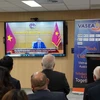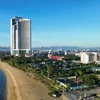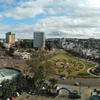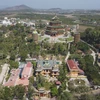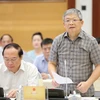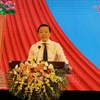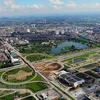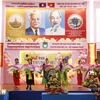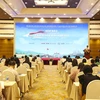 To develop the first ever money printing factory, credit should be given to patriotic capitalist Do Dinh Thien. In the early years of independence, the country’s ability to create industries was difficult as the budget was exhausted. The government decided to set up a money printing factory for the Ministry of Finance to issue banknotes of the independent Vietnam. At that time, Do Dinh Thien spent a big fortune to purchase the Hanoi-based Taupin Printing House, one of the two largest and most modern printing enterprises in Vietnam. He donated it to the government, which was in need by that time. (Photo: Vietnamplus)
To develop the first ever money printing factory, credit should be given to patriotic capitalist Do Dinh Thien. In the early years of independence, the country’s ability to create industries was difficult as the budget was exhausted. The government decided to set up a money printing factory for the Ministry of Finance to issue banknotes of the independent Vietnam. At that time, Do Dinh Thien spent a big fortune to purchase the Hanoi-based Taupin Printing House, one of the two largest and most modern printing enterprises in Vietnam. He donated it to the government, which was in need by that time. (Photo: Vietnamplus)  The Ministry of Finance then moved part of the factory to Chi Ne plantation, which was also owned by Do Dinh Thien. The first banknotes of independent Vietnam were somewhat plain and the quality was not good but the people were very enthusiastic because they represented independence, freedom and national sovereignty. On the banknotes was the portrait of President Ho Chi Minh. The first banknotes became a political weapon of struggle on the economic and financial front and a way of rejecting the Indochina banknotes of the French. The banknote with the largest value was 100 VND, which was called the "green buffalo" banknote as it had a picture of a buffalo on the back of it. (Photo: Vietnamplus)
The Ministry of Finance then moved part of the factory to Chi Ne plantation, which was also owned by Do Dinh Thien. The first banknotes of independent Vietnam were somewhat plain and the quality was not good but the people were very enthusiastic because they represented independence, freedom and national sovereignty. On the banknotes was the portrait of President Ho Chi Minh. The first banknotes became a political weapon of struggle on the economic and financial front and a way of rejecting the Indochina banknotes of the French. The banknote with the largest value was 100 VND, which was called the "green buffalo" banknote as it had a picture of a buffalo on the back of it. (Photo: Vietnamplus)  After a bomb attack, the old money printing factory was destroyed. The current building has been restored and is a relic, a stopover for tourists who want to learn about the history of Vietnamese currency. On the banknotes was the portrait of President Ho Chi Minh. The first banknotes became a political weapon of struggle on the economic and financial front and a way of rejecting the Indochina banknotes of the French. The banknote with the largest value was VND100, which was called the "green buffalo" banknote as it had a picture of a buffalo on the back of it. This factory has become a relic site since 2010. The site covers 15.5 hectares. (Photo: Vietnamplus)
After a bomb attack, the old money printing factory was destroyed. The current building has been restored and is a relic, a stopover for tourists who want to learn about the history of Vietnamese currency. On the banknotes was the portrait of President Ho Chi Minh. The first banknotes became a political weapon of struggle on the economic and financial front and a way of rejecting the Indochina banknotes of the French. The banknote with the largest value was VND100, which was called the "green buffalo" banknote as it had a picture of a buffalo on the back of it. This factory has become a relic site since 2010. The site covers 15.5 hectares. (Photo: Vietnamplus)  Tour guide Bui Thanh Huong introduces the scale of the first money printing factory of the Democratic Republic of Vietnam. This place has two money printing factories - formerly a French plantation, later bought by Mr. Do Dinh Thien. To develop the first money printing plant, credit should be given to patriotic capitalist Do Dinh Thien. In the early years of independence, the country faced difficulty as the national budget was exhausted. The government decided to set up a money printing factory for the Ministry of Finance to issue banknotes of the independent Vietnam. At that time Thien spent a fortune to purchase the Hanoi-based Taupin Printing House, one of the two largest and most modern printing enterprises in Vietnam. He donated it to the government. (Photo: Vietnamplus)
Tour guide Bui Thanh Huong introduces the scale of the first money printing factory of the Democratic Republic of Vietnam. This place has two money printing factories - formerly a French plantation, later bought by Mr. Do Dinh Thien. To develop the first money printing plant, credit should be given to patriotic capitalist Do Dinh Thien. In the early years of independence, the country faced difficulty as the national budget was exhausted. The government decided to set up a money printing factory for the Ministry of Finance to issue banknotes of the independent Vietnam. At that time Thien spent a fortune to purchase the Hanoi-based Taupin Printing House, one of the two largest and most modern printing enterprises in Vietnam. He donated it to the government. (Photo: Vietnamplus)  For the first time, banknotes of the Democratic Republic of Vietnam were printed and circulated nationwide thanks to the factory’s staff. Do Dinh Thien was a patriotic capitalist who donated his family’s legacy to the fight for national independence and freedom. Chi Ne plantation was also a place where Party and State high-ranking officials stopped for a short while, including President Ho on February 19 and February 21, 1947 during a work trip to the central province of Thanh Hoa. Accompanied by Finance Minister Le Van Hien and Director of the factory Pham Quang Chuc, the leader talked with officials, workers and guards of the factory. (Photo: Vietnamplus)
For the first time, banknotes of the Democratic Republic of Vietnam were printed and circulated nationwide thanks to the factory’s staff. Do Dinh Thien was a patriotic capitalist who donated his family’s legacy to the fight for national independence and freedom. Chi Ne plantation was also a place where Party and State high-ranking officials stopped for a short while, including President Ho on February 19 and February 21, 1947 during a work trip to the central province of Thanh Hoa. Accompanied by Finance Minister Le Van Hien and Director of the factory Pham Quang Chuc, the leader talked with officials, workers and guards of the factory. (Photo: Vietnamplus)  Accompanied by Finance Minister Le Van Hien and Director of the factory Pham Quang Chuc, the leader talked with officials, workers and guards of the factory. Dinh Thi Binh, deputy head of the district’s relic site management board, said the factory was classified as a national relic site by the Ministry of Culture, Sports and Tourism in 2007. Work started restoring the relic site in 2010 with a view to restoring the money-printing factory to its original shape. The site is currently divided into three major areas, including a memorial dedicated to President Ho Chi Minh which welcomes visitors during holidays, a money-printing factory (1946-1947) with two rows of artifacts, and a banknote warehouse. The factory was also named in the Guinness Vietnam records as the first of its kind in the country. (Photo: Vietnamplus)
Accompanied by Finance Minister Le Van Hien and Director of the factory Pham Quang Chuc, the leader talked with officials, workers and guards of the factory. Dinh Thi Binh, deputy head of the district’s relic site management board, said the factory was classified as a national relic site by the Ministry of Culture, Sports and Tourism in 2007. Work started restoring the relic site in 2010 with a view to restoring the money-printing factory to its original shape. The site is currently divided into three major areas, including a memorial dedicated to President Ho Chi Minh which welcomes visitors during holidays, a money-printing factory (1946-1947) with two rows of artifacts, and a banknote warehouse. The factory was also named in the Guinness Vietnam records as the first of its kind in the country. (Photo: Vietnamplus)  The factory is located inside a 7,300-hectare plantation which was donated to the State by Vietnamese patriotic capitalist Do Dinh Thien shortly after Vietnam proclaimed its independence on September 2, 1945. Thien reportedly spent 2,000 taels of gold buying the plantation from a French landlord. A tael equals 1.2 troy ounces. Most steps in the money printing process were completed manually. Despite their low quality and aesthetic value, the Vietnamese banknotes produced at the time marked a historic milestone in the country when they were officially used on February 3, 1946, replacing the French Indochinese piaster. After the French military bombed the area in 1947 during the First Indochina War (1946–1954), the money printing factory was moved to Viet Bac base in northern Vietnam. Later, the factory was restored and developed into a historical site covering an area of 15.5 hectares. (Photo: Vietnamplus)
The factory is located inside a 7,300-hectare plantation which was donated to the State by Vietnamese patriotic capitalist Do Dinh Thien shortly after Vietnam proclaimed its independence on September 2, 1945. Thien reportedly spent 2,000 taels of gold buying the plantation from a French landlord. A tael equals 1.2 troy ounces. Most steps in the money printing process were completed manually. Despite their low quality and aesthetic value, the Vietnamese banknotes produced at the time marked a historic milestone in the country when they were officially used on February 3, 1946, replacing the French Indochinese piaster. After the French military bombed the area in 1947 during the First Indochina War (1946–1954), the money printing factory was moved to Viet Bac base in northern Vietnam. Later, the factory was restored and developed into a historical site covering an area of 15.5 hectares. (Photo: Vietnamplus)  On the banknotes was the portrait of President Ho Chi Minh. The first banknotes became a political weapon of struggle on the economic and financial front and a way of rejecting the Indochina banknotes of the French. The banknote with the largest value was 100 VND, which was called the "green buffalo" banknote as it had a picture of a buffalo on the back of it. Most steps in the money printing process there were completed manually. Despite their low quality and aesthetic value, the Vietnamese banknotes produced at the time marked a historic milestone in the country when they were officially used on February 3, 1946, replacing the French Indochinese piaster. (Photo: Vietnamplus)
On the banknotes was the portrait of President Ho Chi Minh. The first banknotes became a political weapon of struggle on the economic and financial front and a way of rejecting the Indochina banknotes of the French. The banknote with the largest value was 100 VND, which was called the "green buffalo" banknote as it had a picture of a buffalo on the back of it. Most steps in the money printing process there were completed manually. Despite their low quality and aesthetic value, the Vietnamese banknotes produced at the time marked a historic milestone in the country when they were officially used on February 3, 1946, replacing the French Indochinese piaster. (Photo: Vietnamplus)  Dinh Thi Binh, deputy head of the district’s relic site management board, said the factory was classified as a national relic site by the Ministry of Culture, Sports and Tourism in 2007. Restoration work started on the relic site in 2010, with a view to restoring the money-printing factory to its original grandeur. The site is currently divided into three major areas, including a memorial dedicated to President Ho Chi Minh which welcomes visitors during holidays, a money-printing factory (1946-1947) with two rows of artifacts and a banknote warehouse. The factory was also named in the Guinness Vietnam records as the first of its kind in the country. (Photo: Vietnamplus)
Dinh Thi Binh, deputy head of the district’s relic site management board, said the factory was classified as a national relic site by the Ministry of Culture, Sports and Tourism in 2007. Restoration work started on the relic site in 2010, with a view to restoring the money-printing factory to its original grandeur. The site is currently divided into three major areas, including a memorial dedicated to President Ho Chi Minh which welcomes visitors during holidays, a money-printing factory (1946-1947) with two rows of artifacts and a banknote warehouse. The factory was also named in the Guinness Vietnam records as the first of its kind in the country. (Photo: Vietnamplus)  Most steps in the money printing process there were completed manually. Despite their low quality and aesthetic value, the Vietnamese banknotes produced at the time marked a historic milestone in the country when they were officially used on February 3, 1946, replacing the French Indochinese piaster. On the banknotes was the portrait of President Ho Chi Minh. The first banknotes became a political weapon of the struggle on the economic and financial front and a way of rejecting the Indochina banknotes of the French. The banknote with the largest value was 100 VND, which was called the "green buffalo" banknote as it had a picture of a buffalo on the back of it. (Photo: Vietnamplus)
Most steps in the money printing process there were completed manually. Despite their low quality and aesthetic value, the Vietnamese banknotes produced at the time marked a historic milestone in the country when they were officially used on February 3, 1946, replacing the French Indochinese piaster. On the banknotes was the portrait of President Ho Chi Minh. The first banknotes became a political weapon of the struggle on the economic and financial front and a way of rejecting the Indochina banknotes of the French. The banknote with the largest value was 100 VND, which was called the "green buffalo" banknote as it had a picture of a buffalo on the back of it. (Photo: Vietnamplus)  For the first time, banknotes of the Democratic Republic of Vietnam were printed and circulated nationwide thanks to the factory’s staff. Thien was a patriotic capitalist who donated his family’s legacy to the fight for national independence and freedom. Chi Ne plantation was also a place where Party and State high-ranking officials stopped for a short while, including President Ho Chi Minh on February 19 and February 21, 1947 during a work trip to the central province of Thanh Hoa. Accompanied by Finance Minister Le Van Hien and Director of the factory Pham Quang Chuc, the leader talked with officials, workers and guards of the factory. (Photo: Vietnamplus)
For the first time, banknotes of the Democratic Republic of Vietnam were printed and circulated nationwide thanks to the factory’s staff. Thien was a patriotic capitalist who donated his family’s legacy to the fight for national independence and freedom. Chi Ne plantation was also a place where Party and State high-ranking officials stopped for a short while, including President Ho Chi Minh on February 19 and February 21, 1947 during a work trip to the central province of Thanh Hoa. Accompanied by Finance Minister Le Van Hien and Director of the factory Pham Quang Chuc, the leader talked with officials, workers and guards of the factory. (Photo: Vietnamplus)  Most steps in the money printing process there were completed manually. Despite their low quality and aesthetic value, the Vietnamese banknotes produced at the time marked a historic milestone in the country when they were officially used on February 3, 1946, replacing the French Indochinese piaster. On the banknotes was the portrait of President Ho Chi Minh. The first banknotes became a political weapon of struggle on the economic and financial front and a way of rejecting the Indochina banknotes of the French. The banknote with the largest value was 100 VND, which was called the "green buffalo" banknote as it had a picture of a buffalo on the back of it. (Photo: Vietnamplus)
Most steps in the money printing process there were completed manually. Despite their low quality and aesthetic value, the Vietnamese banknotes produced at the time marked a historic milestone in the country when they were officially used on February 3, 1946, replacing the French Indochinese piaster. On the banknotes was the portrait of President Ho Chi Minh. The first banknotes became a political weapon of struggle on the economic and financial front and a way of rejecting the Indochina banknotes of the French. The banknote with the largest value was 100 VND, which was called the "green buffalo" banknote as it had a picture of a buffalo on the back of it. (Photo: Vietnamplus)  Coins of various denominations issued by the Ministry of Finance, the National Bank of Vietnam, were popularly used in the period 1945-1976. The first banknotes of independent Vietnam were mostly plain and the quality was not good but the people were very enthusiastic because they represented independence, freedom and national sovereignty. On the banknotes was the portrait of President Ho Chi Minh. The first banknotes became a political weapon of struggle on the economic and financial front and a way of rejecting the Indochina banknotes of the French. The banknote with the largest value was 100 VND, which was called the "green buffalo" banknote as it had a picture of a buffalo on the back of it. (Photo: Vietnamplus)
Coins of various denominations issued by the Ministry of Finance, the National Bank of Vietnam, were popularly used in the period 1945-1976. The first banknotes of independent Vietnam were mostly plain and the quality was not good but the people were very enthusiastic because they represented independence, freedom and national sovereignty. On the banknotes was the portrait of President Ho Chi Minh. The first banknotes became a political weapon of struggle on the economic and financial front and a way of rejecting the Indochina banknotes of the French. The banknote with the largest value was 100 VND, which was called the "green buffalo" banknote as it had a picture of a buffalo on the back of it. (Photo: Vietnamplus)  The coins are associated with a historical period of the Vietnamese nation. For the first time, banknotes of the Democratic Republic of Vietnam were printed and circulated nationwide thanks to the factory’s staff. Thien was a patriotic capitalist who donated his family’s legacy to the fight for national independence and freedom. Chi Ne plantation was also a place where Party and State high-ranking officials stopped for a short while, including President Ho Chi Minh on February 19 and February 21, 1947 during a work trip to the central province of Thanh Hoa. Accompanied by Finance Minister Le Van Hien and Director of the factory Pham Quang Chuc, the leader talked with officials, workers and guards of the factory. (Photo: Vietnamplus)
The coins are associated with a historical period of the Vietnamese nation. For the first time, banknotes of the Democratic Republic of Vietnam were printed and circulated nationwide thanks to the factory’s staff. Thien was a patriotic capitalist who donated his family’s legacy to the fight for national independence and freedom. Chi Ne plantation was also a place where Party and State high-ranking officials stopped for a short while, including President Ho Chi Minh on February 19 and February 21, 1947 during a work trip to the central province of Thanh Hoa. Accompanied by Finance Minister Le Van Hien and Director of the factory Pham Quang Chuc, the leader talked with officials, workers and guards of the factory. (Photo: Vietnamplus)  The Truong Son money set was issued in 1966-1973 in the form of vouchers. The coins are associated with a historical period of the Vietnamese nation. For the first time, banknotes of the Democratic Republic of Vietnam were printed and circulated nationwide thanks to the factory’s staff. Do Dinh Thien was a patriotic capitalist who donated his family’s legacy to the fight for national independence and freedom. Chi Ne plantation was also a place where Party and State high-ranking officials stopped for a short while, including President Ho Chi Minh on February 19 and February 21, 1947 during a work trip to the central province of Thanh Hoa. Accompanied by Finance Minister Le Van Hien and Director of the factory Pham Quang Chuc, the leader talked with officials, workers and guards of the factory. (Photo: Vietnamplus)
The Truong Son money set was issued in 1966-1973 in the form of vouchers. The coins are associated with a historical period of the Vietnamese nation. For the first time, banknotes of the Democratic Republic of Vietnam were printed and circulated nationwide thanks to the factory’s staff. Do Dinh Thien was a patriotic capitalist who donated his family’s legacy to the fight for national independence and freedom. Chi Ne plantation was also a place where Party and State high-ranking officials stopped for a short while, including President Ho Chi Minh on February 19 and February 21, 1947 during a work trip to the central province of Thanh Hoa. Accompanied by Finance Minister Le Van Hien and Director of the factory Pham Quang Chuc, the leader talked with officials, workers and guards of the factory. (Photo: Vietnamplus)  Old stock notes of Indochina. After a bomb attack, the old money printing factory was destroyed. The current building has been restored to its old appearance and becomes a relic, a stopover for tourists who want to learn about the history of Vietnamese currency. On the banknotes was the portrait of President Ho Chi Minh. The first banknotes became a political weapon of struggle on the economic and financial front and a way of rejecting the Indochina banknotes of the French. The banknote with the largest value was VND100, which was called the "green buffalo" banknote as it had a picture of a buffalo on the back of it. This factory has become a relic site since 2010. The site covers 15.5 hectares. (Photo: Vietnamplus)
Old stock notes of Indochina. After a bomb attack, the old money printing factory was destroyed. The current building has been restored to its old appearance and becomes a relic, a stopover for tourists who want to learn about the history of Vietnamese currency. On the banknotes was the portrait of President Ho Chi Minh. The first banknotes became a political weapon of struggle on the economic and financial front and a way of rejecting the Indochina banknotes of the French. The banknote with the largest value was VND100, which was called the "green buffalo" banknote as it had a picture of a buffalo on the back of it. This factory has become a relic site since 2010. The site covers 15.5 hectares. (Photo: Vietnamplus)  The front of the banknote is the image of Uncle Ho, next to the rice flowers and the farmer working hard to make the background blurred. The image expresses the desire for a free, prosperous and happy life. The first banknotes of independent Vietnam were quite plain and the quality was not good but the people were very enthusiastic because they represented independence, freedom and national sovereignty. On the banknotes was the portrait of President Ho Chi Minh. The first banknotes became a political weapon of struggle on the economic and financial front and a way of rejecting the Indochina banknotes of the French. (Photo: Vietnamplus)
The front of the banknote is the image of Uncle Ho, next to the rice flowers and the farmer working hard to make the background blurred. The image expresses the desire for a free, prosperous and happy life. The first banknotes of independent Vietnam were quite plain and the quality was not good but the people were very enthusiastic because they represented independence, freedom and national sovereignty. On the banknotes was the portrait of President Ho Chi Minh. The first banknotes became a political weapon of struggle on the economic and financial front and a way of rejecting the Indochina banknotes of the French. (Photo: Vietnamplus)  Bank notes printed in 1958. The first banknotes of independent Vietnam were somewhat plain and the quality was not good but the people were very enthusiastic because they represented independence, freedom and national sovereignty. On the banknotes was the portrait of President Ho Chi Minh. The first banknotes became a political weapon of struggle on the economic and financial front and a way of rejecting the Indochina banknotes of the French. The front of the banknote is the image of Uncle Ho, next to the rice flowers and the farmer working hard to make the background blurred. The image expresses the desire for a free, prosperous and happy life. The banknote with the largest value was 100 VND, which was called the "green buffalo" banknote as it had a picture of a buffalo on the back. (Photo: Vietnamplus)
Bank notes printed in 1958. The first banknotes of independent Vietnam were somewhat plain and the quality was not good but the people were very enthusiastic because they represented independence, freedom and national sovereignty. On the banknotes was the portrait of President Ho Chi Minh. The first banknotes became a political weapon of struggle on the economic and financial front and a way of rejecting the Indochina banknotes of the French. The front of the banknote is the image of Uncle Ho, next to the rice flowers and the farmer working hard to make the background blurred. The image expresses the desire for a free, prosperous and happy life. The banknote with the largest value was 100 VND, which was called the "green buffalo" banknote as it had a picture of a buffalo on the back. (Photo: Vietnamplus)  There is also an oil painting here depicting a money model The Green Buffalo by artist Nguyen Huyen. The money model has vivid and practical images for Vietnam at the time, showing the guidelines of the Party and Government. The images represent the development of the revolution and the resistance war. Artists, including painter Nguyen Huyen - who directly made the drawings, had to work hard to forget time, sometimes going to the construction site, factory, sometimes going to the countryside to get images – to add a dynamic flair to the drawings. On the banknotes was the portrait of President Ho Chi Minh. The first banknotes became a political weapon of struggle on the economic and financial front and a way of rejecting the Indochina banknotes of the French. The banknote with the largest value was 100 VND, which was called the "green buffalo" banknote as it had a picture of a buffalo on the back of it. (Photo: Vietnamplus)
There is also an oil painting here depicting a money model The Green Buffalo by artist Nguyen Huyen. The money model has vivid and practical images for Vietnam at the time, showing the guidelines of the Party and Government. The images represent the development of the revolution and the resistance war. Artists, including painter Nguyen Huyen - who directly made the drawings, had to work hard to forget time, sometimes going to the construction site, factory, sometimes going to the countryside to get images – to add a dynamic flair to the drawings. On the banknotes was the portrait of President Ho Chi Minh. The first banknotes became a political weapon of struggle on the economic and financial front and a way of rejecting the Indochina banknotes of the French. The banknote with the largest value was 100 VND, which was called the "green buffalo" banknote as it had a picture of a buffalo on the back of it. (Photo: Vietnamplus)  In 2007, Vietnam's first money printing factory was ranked a national monument by the Ministry of Culture, Sports and Tourism. With historical imprints and special significance, on February 14, 2014, the site of the Money Printing Factory at Chi Ne Plantation (period 1946-1947) was awarded a Guinness Vietnam record as the first money factory. The site is currently divided into three major areas, including a memorial dedicated to President Ho Chi Minh which welcomes visitors during holidays, a money-printing factory (1946-1947) with two rows of artifacts, and a banknote warehouse. The factory was also named in the Guinness Vietnam records as the first of its kind in the country. (Photo: Vietnamplus)
In 2007, Vietnam's first money printing factory was ranked a national monument by the Ministry of Culture, Sports and Tourism. With historical imprints and special significance, on February 14, 2014, the site of the Money Printing Factory at Chi Ne Plantation (period 1946-1947) was awarded a Guinness Vietnam record as the first money factory. The site is currently divided into three major areas, including a memorial dedicated to President Ho Chi Minh which welcomes visitors during holidays, a money-printing factory (1946-1947) with two rows of artifacts, and a banknote warehouse. The factory was also named in the Guinness Vietnam records as the first of its kind in the country. (Photo: Vietnamplus)  To set up the first ever money printing plant, credit should be given to patriotic capitalist Do Dinh Thien. In the early years of independence, the country fell into difficulty as the national budget was exhausted. The Vietnamese Government decided to set up a money printing factory for the Ministry of Finance to issue banknotes of the independent Vietnam. At that time Do Dinh Thien spent a huge fortune to purchase the Hanoi-based Taupin Printing House, one of the two largest and most modern printing enterprises across the country. He donated it to the government, which was in need at that time. (Photo: Vietnamplus)
To set up the first ever money printing plant, credit should be given to patriotic capitalist Do Dinh Thien. In the early years of independence, the country fell into difficulty as the national budget was exhausted. The Vietnamese Government decided to set up a money printing factory for the Ministry of Finance to issue banknotes of the independent Vietnam. At that time Do Dinh Thien spent a huge fortune to purchase the Hanoi-based Taupin Printing House, one of the two largest and most modern printing enterprises across the country. He donated it to the government, which was in need at that time. (Photo: Vietnamplus)  The memorial house for people with meritorious services and officials and workers of the money printing factory at Chi Ne plantation was inaugurated and put into operation from May 2019. The site is currently divided into three major areas, including a memorial dedicated to late President Ho Chi Minh which welcomes visitors during holidays, together with a money-printing factory (1946-1947) with two rows of artifacts and a banknote warehouse.
The memorial house for people with meritorious services and officials and workers of the money printing factory at Chi Ne plantation was inaugurated and put into operation from May 2019. The site is currently divided into three major areas, including a memorial dedicated to late President Ho Chi Minh which welcomes visitors during holidays, together with a money-printing factory (1946-1947) with two rows of artifacts and a banknote warehouse.The factory was also named in the Guinness Vietnam records as the first of its kind in the country. This factory has become a relic site since 2010. The site covers 15.5 hectares. (Photo: Vietnamplus)
 Inside the central compartment is a statue of Uncle Ho. On the banknotes was the portrait of President Ho Chi Minh. The first banknotes became a political weapon of struggle on the economic and financial front and a way of rejecting the Indochina banknotes of the French. The banknote with the largest value was VND100, which was called the "green buffalo" banknote as it had a picture of a buffalo on the back of it. The first banknotes of independent Vietnam were somewhat plain and the quality was not good but the people were very enthusiastic because they represented independence, freedom and national sovereignty. This factory has become a relic site since 2010. The site covers 15.5 hectares. Some pictures of the first money-printing factory in Vietnam. (Photo: Vietnamplus)
Inside the central compartment is a statue of Uncle Ho. On the banknotes was the portrait of President Ho Chi Minh. The first banknotes became a political weapon of struggle on the economic and financial front and a way of rejecting the Indochina banknotes of the French. The banknote with the largest value was VND100, which was called the "green buffalo" banknote as it had a picture of a buffalo on the back of it. The first banknotes of independent Vietnam were somewhat plain and the quality was not good but the people were very enthusiastic because they represented independence, freedom and national sovereignty. This factory has become a relic site since 2010. The site covers 15.5 hectares. Some pictures of the first money-printing factory in Vietnam. (Photo: Vietnamplus)  An altar set up in memory of Do Dinh Thien and his wife. To develop the first money printing plant, credit should be given to patriotic capitalist Do Dinh Thien. In the early years of independence, the country fell into difficulty when the national budget was exhausted. The government decided to set up a money printing factory for the Ministry of Finance to issue banknotes of the independent Vietnam. At that time Thien spent a fortune to purchase the Hanoi-based Taupin Printing House, one of the two largest and most modern printing enterprises in Vietnam. He donated it to the government. The Ministry of Finance then moved part of the factory to Chi Ne plantation, which was also owned by Thien. (Photo: Vietnamplus)
An altar set up in memory of Do Dinh Thien and his wife. To develop the first money printing plant, credit should be given to patriotic capitalist Do Dinh Thien. In the early years of independence, the country fell into difficulty when the national budget was exhausted. The government decided to set up a money printing factory for the Ministry of Finance to issue banknotes of the independent Vietnam. At that time Thien spent a fortune to purchase the Hanoi-based Taupin Printing House, one of the two largest and most modern printing enterprises in Vietnam. He donated it to the government. The Ministry of Finance then moved part of the factory to Chi Ne plantation, which was also owned by Thien. (Photo: Vietnamplus) VNA
